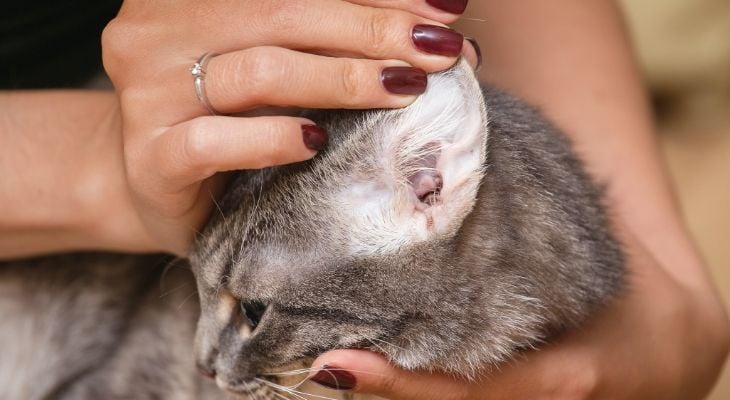
Cats can suffer from a variety of different skin disorders, including feline acne, allergic dermatitis, mites and ringworm. If your cat is frequently itching, scratching, licking his skin beyond normal grooming, or suffering unexplained hair loss, a skin condition may be the cause.
The first step to treating a skin condition is diagnosis of the specific problem. Many skin conditions share similar symptoms, such as hair loss, scabs, or flaky skin. Depending on your cat’s symptoms, a veterinarian may begin by ruling out the most common skin problems.
Allergic Dermatitis
Allergies are very common in cats. While people show their allergies by sneezing, nasal congestion, and red eyes; cats show their allergies in their skin. There are four types of skin problems cats can have as a result of allergies: hair loss without much skin changes; miliary dermatitis - which causes small pinpoint scabs, especially on the neck and over the hips and tail base; eosinophilic granulomas - which are raised, red, hairless lesions, commonly on the lips, but can be lower on the jaw or neck, or even on the rear legs; severe itchiness at the face or neck. The most common allergies are to fleas, pollen, food ingredients, molds, and house dust mites. Unfortunately, any of the allergens can cause any of the patterns.
Fleas
Even if your cat is an indoor pet, another pet in the household may have exposed your cat to fleas, or you may have brought them home! If your cat is allergic to fleas, a single flea bite can trigger a reaction that lasts for days to weeks. Good flea control is essential to preventing allergic dermatitis.
Feline Acne
Feline acne is one of the most common feline skin conditions. That’s right; even cats can suffer from a bad case of pimples! But cats show their acne only on the chin. You may see just blackheads, or the cat may have red, raised bumps on their chin. For most cats, feline acne will simply clear up by itself. However, if your cat’s acne persists, a medicated shampoo, oral antibiotics or a prescription ointment will help.
Mites
There are many kinds of skin mites that can cause skin problems that may look just like allergies. Mites such as Demodex, Cheyletiella, and Notoedres can usually be diagnosed by a skin scraping, and inspection under a microscope. This possibility certainly needs to be investigated before treatment of allergy is started.
Not all skin problems are confined to a cat’s fur. Ear mites (Otodectes) infect the ear, but can extend out into the skin. Symptoms of ear mites include constant itching, scratching at the ear, and shaking the head. Without proper treatment, the constant scratching and itching may lead to a secondary skin infection. With prompt treatment, the proper medicine can clear up the primary problem before secondary infections occur.
Your cat's regular doctor can help with most skin problems. But if there are difficult or persistent problems, a veterinary dermatologist is trained to diagnose and treat all skin disorders. Your veterinarian can help you with a referral. Prompt treatment will help prevent secondary infections or complications and keep your feline healthy.
Source:
American College of Veterinary Dermatology (ACVD)
Bernstein, Joseph A. DVM. "Manifestations of Feline Allergy." Annual Dermatology Continuing Education Conference.

